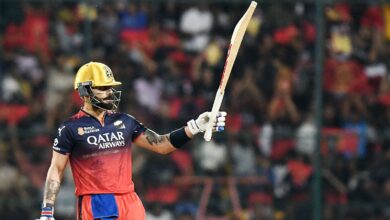Laughed at once, lauded now: How WPL is changing perception around women’s cricket and cricketers | Cricket News

The Women’s Premier League’s (WPL) impact can be gauged in many ways. But nothing captures it better than the emergence of Sajana Sajeevan.Until she was picked Mumbai Indians, the 29-year-old from Wayanad was just another allrounder in the domestic scene. At the first opportunity, Sajana showed she’s much more than that. In her first season, off her first ball – and the game’s final – she hit a six to hand Mumbai Indians an incredible win against the Delhi Capitals in Friday’s season opener.
Just like that, a star was born. Safe to say, Sajana’s six-hitting talent would not have been unearthed if not for the WPL.
“Girls take cricket seriously now,” Sneh Rana, Indian off-spinner and Gujarat Giants’ vice-captain, tells The Indian Express. “Those who might not have considered taking up cricket as a serious profession, those parents who were scared ki cricket mein kya hoga (what will happen in cricket)… that is changing. More players are coming forward, more parents are sending kids to coaching, WPL is a fine platform for that. People used to talk during our time too, there wasn’t this much exposure for women’s cricket. But we kept at it.”
Players from Sneh’s generation – and the stalwarts from before then – had to maintain that level of stubbornness to ignore all the jibes, and keep pushing on despite the lack of avenues. But for those growing up now that will not be the case.
Mumbai Indians batters Sajeevan Sajana and Amanjot Kaur celebrate the WPL 2024 match over Delhi Capitals, at the M Chinnaswamy Stadium in Bengaluru, Friday, Feb. 23, 2024. (PTI Photo)
A viable career option
Ananya Upendran remembers a time when she, and female cricketers, weren’t taken seriously. The former Hyderabad and India A cricketer has been around Indian domestic scene in various capacities for more than a decade now, but when she was still an active cricketer, she saw around her stories of teammates who gave up the sport. “I remember being told a 14-year-old boy when I was 22-23, when I said I play state cricket, he was like, ‘Oh, so what’s the big deal,” she recalls.
A stark reminder of why cricket wasn’t a viable career option for hundreds of women was when she realised at one point in her career that so many of the teammates who grew up playing with her, weren’t around the sport anymore.
“I’ve seen maybe 30-40 teammates of mine opt out of playing once they finish junior-level cricket, or once they reach 20-21. Simply because it wasn’t feasible, you had to have another job once you finished studying to be able to sustain yourself,” Ananya tells this daily.
That was the case unless one was a Railways employee, which made them the domestic stalwarts. The security of a job, and being hired to just play cricket, was not the norm.
“From my batch of around 20-24 Under-19 cricketers in Hyderabad, only four of us graduated into senior cricket and played more than two years. That was simply because at some point parents came in and said, ‘Hey, you need to make a decision. You can’t just constantly be off training, doing something that is not going to be your career. So either you study full time or you find a job’.”
Trickle-down effect
Shikha Pandey has been around for a while and the Indian pacer is pleased the change she has seen at the domestic level in the past year.
Mumbai Indians player Nat Sciver-Brunt with teammates celebrates after taking the wicket of Delhi Capitals batter Meg Lanning during the WPL 2024 match between Delhi Capitals and Mumbai Indians, at the M Chinnaswamy Stadium in Bengaluru, Friday, Feb. 23, 2024. (PTI Photo)
“When I went back to the domestic season after WPL, I found my love back for the sport. I was amazed actually the younger cricketers who have come into the scene, it’s amazing how one year of WPL has brought about a lot of changes in terms of scoring rates going higher, teams trying to be more aggressive,” the Indian pacer, who had a stellar first season for DC, says.
Throughout Shikha’s career with India, when she went back to the domestic side after playing for India, she would often have youngsters approaching her with questions about what it was like to play alongside stars like Harmanpreet Kaur, Smriti Mandhana, Mithali Raj, and Jhulan Goswami.
“But now when another player from the domestic circuit goes to the WPL, rubs shoulders with the stars, then goes back to the domestic circuit, the state cricketers will take that feedback more. They will understand what their peers are capable of. That’s a huge change from last year. The numbers behind WPL in one year have been amazing, and I’m sure when more seasons happen, when teams go up from 5 to 8, more cricketers get an opportunity, and things will only get better.”
Sajana’s slam-bang arrival on the opening night of WPL 2024 is one such instance, as she follows the footsteps of Kerala’s Minnu Mani, who was on the other side in Bengaluru playing for Delhi Capitals.
There is also Gouher Sultana who kept at it in the domestic circuit despite not playing for India since 2014, and finally, at 35, has a contract with the UP Warriorz. From a situation where players had to drop out frequently once they reached a certain age because there was no real future, things are slowly starting to change.
And at the other end of the spectrum, we have seen a youngster like Shreyanka Patil, making a mark early in their careers, delivering results beyond being just starstruck.
“I think the biggest thing in women’s cricket, at least through my career, was that even if you were playing domestic cricket, you weren’t really taken seriously anyone, like whether it was friends, relatives, sometimes even parents,” Ananya recalls.
She adds: “To a large extent, they would have seen it as a hob that maybe paid a little bit, but it was never seen as a career, so I don’t think female domestic cricketers were ever taken seriously, and I think the WPL will change that mindset even there with parents, with relatives, friends, families, and everyone watching.”
While playing for India perhaps remains the ultimate dream for anyone taking up the sport seriously, the WPL offers a more realic dream. Ananya, who is Program Lead at GoSports Foundation for the Equal Hue program and was also on the auction table for DC recently, has seen that in the kind of young talent she gets to work with.
Actor Shah Rukh Khan with the captains of WPL teams Smriti Mandhana (Royal Challengers Bangalore), Harmanpreet Kaur (Mumbai Indians), Meg Lanning (Delhi Capitals), Beth Mooney (Gujarat Giants), Alyssa Healy (UP Warriorz) during the opening ceremony of Women’s Premier League 2024, at M Chinnaswamy Stadium, in Bengaluru. (PTI)
“With a lot of them, the WPL feels like a more realic dream. Because at the end of the day, only 15 people are going to represent the country at any given point. It’s a lot to do with being in the right place at the right time. Now, you don’t just have to be playing for the country to be a professional cricketer, but also to be a successful cricketer.”
WPL’s impact on the global game
In a MOU signed in April 2023, women’s cricket in Australia got a financial boost, with the top WBBL players now earning $130,000, which comes to Rs 72 lakh.
According to ESPNCricinfo, the wages in England’s The Hundred are set to be increased just for the women’s teams from 2024, in a bid to close the gender gap. The highest salary available will be £50,000, which comes to around Rs 52 lakh. Even in the early stages, WPL is bettering those numbers.
The timing for the changes in two top leagues around the world cannot be a coincidence. There is a strong case to be made that even WPL is undervalued in its initial days, given the disparity with the salaries seen in IPL, but in the women’s game, it has set a new global benchmark for remuneration. Boards and leagues have started to realise it.
It is not lost on the best of international cricketers either. “Obviously the WPL is growing and a lot more girls are taking up the sport. Hopefully one of us (India and England) can take over (from Australia). There’s not much of a gap left anymore,” says England’s world No 1 white-ball bowler Sophie Ecclestone.
In the end, beyond the love for the sport, a cricketer grows up hoping to make a career out of it like any other professional. For the longest time, female cricketers had to wait for their time. But started Australia, and now on the cusp of a revolution led India, the women’s game is carving its own space.






